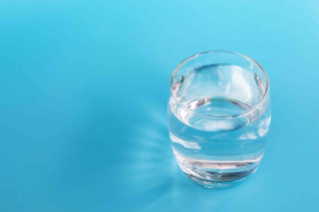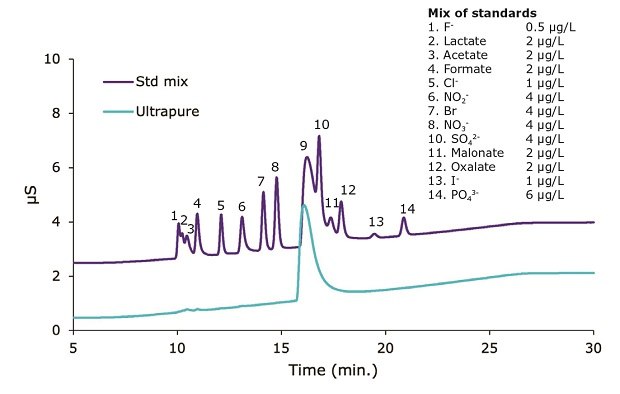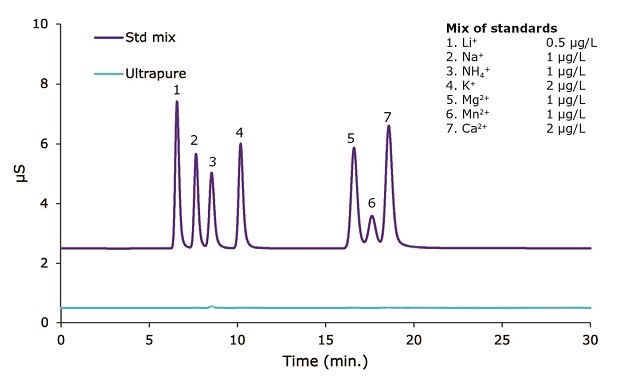Drinking Water Testing by Ion Chromatography using Ultrapure Water
Merina Corpinot Ph.D.1, Estelle Riche Ph.D.2, Beatrice Frocrain1, Cecilia Devaux1, Stephane Mabic Ph.D.2
1R&D, Lab Water Solutions, Merck, Guyancourt, France, 2Marketing, Lab Water Solutions, Merck, Guyancourt, France

Drinking water is the most essential beverage for our health, therefore its quality is strictly regulated.1,2 Inorganic ions in water can be detrimental to health (e.g., nitrates and nitrites), while other ions may influence water’s organoleptic properties. For example, chloride and sulfate ions may induce a noticeable, unpleasant taste.
Water is frequently treated with chemicals to control bacteria and remove pathogens. These chemicals can generate harmful disinfection by-products (DBPs) when they react with organic molecules naturally present in water.3 For these reasons, ion and DBP concentrations in drinking water are highly monitored and controlled, and techniques are constantly evolving to accurately detect and quantify them.
Section Overview
- Ion Chromatography for Drinking Water Analysis
- IC analysis of ions in ultrapure and drinking water samples
- IC analysis of disinfection by-products in ultrapure and drinking water samples
- Suitability of ultrapure water produced by a Milli-Q® water purification system for the IC analysis of drinking water
- Related Products
Ion Chromatography for Drinking Water Analysis
Ion chromatography (IC) is a common analytical technique to test water samples for contaminants. Purified water is used in multiple steps of the IC workflow. For example, to prepare samples, standards and blanks, as well as for water-based eluents. Water is therefore a key reagent and should be of the highest quality to obtain accurate and reliable IC results.
In this article, we assess the suitability of ultrapure water produced by a Milli-Q® IQ 7000 water purification system for the IC analyses of inorganic ions and DBPs in drinking water.
IC analysis of ions in ultrapure and drinking water samples
We analyzed tap water and ultrapure water that was freshly delivered by a Milli-Q® IQ 7000 system. This purification system delivers water with resistivity of 18.2 MOhm.cm at 25 °C and total organic carbon (TOC) < 5 ppb. The system was fed with pure water from an Elix® electrodeionization (EDI)-based system and fitted with a 0.22 µm Millipak® final filter.
Inorganic ion concentrations assessed in the ultrapure water were either not detectable or were below the limit of detection (LOD). For example, nitrate (NO3-) levels in the ultrapure water were 140,000-fold lower than the lowest limits defined by the WHO and European regulatory bodies. This was observed even though the tap water feeding the water purification chain contained large amounts of these ions (Table 1).
Figure 1 and Figure 2 show ion chromatograms of ultrapure water compared to those of anionic and cationic standard mixtures, respectively.

Figure 1.Ion chromatograms of ultrapure water from a Milli-Q® IQ 7000 water purification system and of a mix of anionic standards. Peak 9: carbonate.

Figure 2.Ion chromatograms of ultrapure water from a Milli-Q® IQ 7000 system, and of a mix of catonic standards.
These results demonstrate that freshly delivered ultrapure water from a Milli-Q® IQ 7000 system is well-suited for use in IC analysis. This water may confidently be used for blanks and to preparate samples, standards and eluents. Ultrapure water from the system is also suitable to analyze drinking water as it contains extremely low levels of inorganic ions.
Experimental method
For inorganic anions:
- Instrument: Thermo Scientific Dionex™ ICS-3000 system
- Columns: Anion concentrator: IonPac™ UTAC-ULP1 5 x 23 mm; Guard column: IonPac™ AG19 2 x 50 mm; Analytical column: IonPac™ AS19 2 x 250 mm
- Eluent: KOH gradient: 1 to 35 mM KOH from 0 to 20 min; 35 mM from 20 to 25 min; 35 to 1 mM from 25 to 25.1 min; 1 mM from 25.1 to 30 min
- Eluent source: EG40 with KOH cartridge and ultrapure water from an ICW-3000™ direct IC feed system; Flow rate: 0.25 mL/min
- Detection: Suppressed conductivity; Eluent suppressor: ASRS® Ultra II 2 mm
- Samples and standards: sample volume was 40 mL (pre-concentrated: 40 mL sample is concentrated on a cartridge, and the concentrated sample is injected on a column after desorption). TraceCERT® standards were used.
For inorganic cations, the same method was used, but with an MSA gradient and a CS12A analytical column.
IC analysis of disinfection by-products in ultrapure and drinking water samples
To maintain safe drinking water, a critical amount of disinfectant must be added to kill pathogens while also minimizing the production of DBPs to levels that are below acceptable limits.
The EPA5 and WHO2 have set the maximum level of bromate permissible in tap water at 10 μg/L. The FDA adopts this same regulatory limit for bottled water.4 In Europe, natural mineral waters and spring waters treated by ozonation have a maximum permissible bromate limit of 3 μg/L6; this value is 10 µg/L for drinking water.1 Levels of bromate, chlorate and chlorite in drinking water are commonly assessed by IC following EPA method 300.1.7
We analyzed tap water and ultrapure water freshly delivered from a Milli-Q® IQ 7000 system equipped with a Millipak® final filter. Bromate, chlorate and chlorite levels in the ultrapure water were below the limits set by regulatory bodies (Table 2). Even if some DBPs were present in the feed tap water, DBPs were not detected in the ultrapure water dispensed from the system.
The combination of technologies in the water purification chain (consisting of an Elix® EDI-based system feeding a Milli-Q® IQ 7000 system) efficiently removes trace levels of DBPs to produce ultrapure water that is suitable for drinking water analysis by IC.
Experimental method
Analyses were performed by an independent accredited (COFRAC) laboratory.
- Chlorite and chlorate: according to norm NF EN ISO 10304-4
- Bromate: according to norm NF EN ISO 15061
- Eluent: carbonate/bicarbonate
- Column: Metrohm Metrosep A supp 7 – 250/4.0, 45 °C, suppressed conductivity detection

Suitability of ultrapure water produced by a Milli-Q® water purification system for the IC analysis of drinking water
This study demonstrates that ultrapure water freshly produced by a Milli-Q® IQ 7000 water purification system is suitable for the tasks performed as part of the IC analysis of drinking water. Specifically, for the preparation of eluents, samples, and standards, and for use as blanks. Even if the tap water feeding the system contains the ions to be measured, these contaminants are removed by the combination of technologies present in the water purification chain.
A Milli-Q® IQ 7000 ultrapure water system can be fed by an Milli-Q® IX pure water system, which includes Elix® EDI technology. Alternatively, a Milli-Q® IQ 7003/05/10/15 pure and ultrapure system dispenses ultrapure water suitable for IC analysis using tap water as its feed source.
Related Products
References
To continue reading please sign in or create an account.
Don't Have An Account?